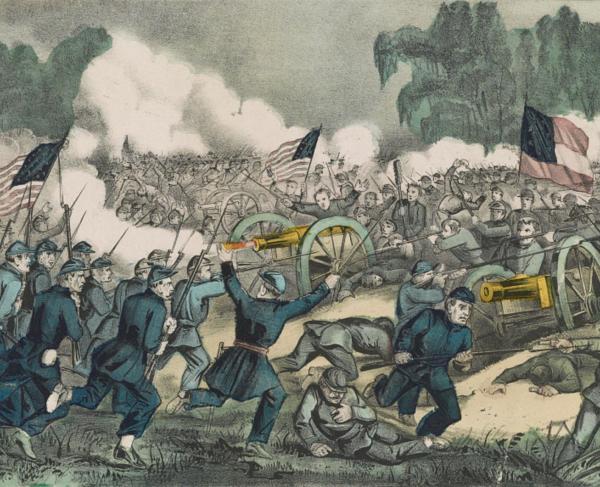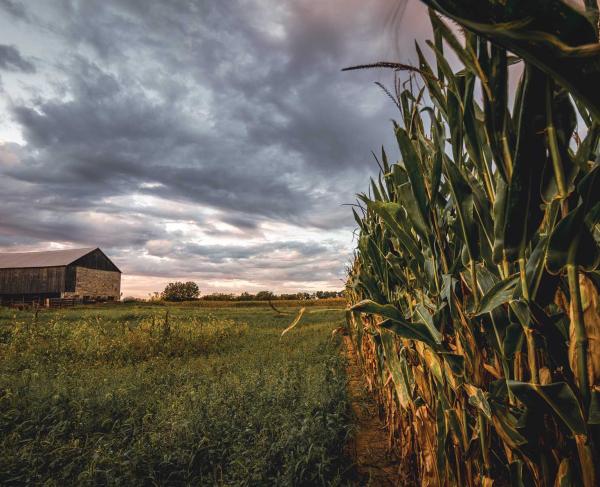The Flags of Antietam

The Civil War Trust has partnered with leading Civil War flag conservancies and military museums to present to you this selection of authentic Civil War flags that flew with units that fought at the Battle of Antietam. The flags are presented in rough chronological order - showcasing these remarkable artifacts that were prized by men who carried them into the maelstrom of Antietam.
The Lost Order
The 27th Indiana Volunteers

On the morning on September 13, 1862, Corporal Barton Mitchell of the 27th Indiana discovered Robert E. Lee’s Special Order 191 wrapped with three cigars in a field on the Best Farm, not far from Frederick, Maryland. This discovery of Lee’s Maryland Campaign plans would energize the Army of Potomac's pursuit of Lee’s divided forces in Maryland.
At the Battle of Antietam, the 27th Indiana, part of the Union XII Corps, suffered tremendous casualties as it advanced through the Miller Cornfield. By the end of the Maryland Campaign the 27th Indiana had lost almost 50% of its soldiers.
Primary Source: More on Special Orders 191 »
Indiana War Memorial | See More Indiana Flags
The Cornfield and Hagerstown Pike
The 2nd Wisconsin Volunteers

Part of the famed Iron Brigade, the men of the 2nd Wisconsin Infantry Regiment carried these colors during their morning attack at the Battle of Antietam. Already depleted by their heavy casualties at the Battle of Brawner’s Farm and South Mountain, the 2nd pressed forward into the West Woods on the morning of September 17, 1862. Assailed by Jackson’s Confederates, the entire Iron Brigade fought a desperate fight that further reinforced its reputation as one of the hardest fighting brigades in the Union army. Entering the battle with 150 men, the 2nd Wisconsin lost another 91 during its epic fight at Antietam.
The Wisconsin Veterans Museum (Madison, WI) | See more Wisconsin Flags »
The 47th Alabama

Part of Taliaferro’s Brigade in Jackson’s Corps, the 47th Alabama lined the Hagerstown Pike to the right of Starke’s Louisianans. Facing elements of the Union Iron Brigade, the 47th was forced back towards the West Woods. During the heavy fighting in and around this position, Private Stanislas Beneaux, of Company E, 35th New York Volunteers, captured this flag during their advance – an event that was noted in Brig. Gen. Marsena Patrick’s official report issued after the battle. After the Civil War ended, this cotton flag with its 15 appliqued stars, was displayed at the Great Wardrobe Clothing Store in Watertown, New York before becoming a part of the New York State Battle Flag collection. During the 1862 Maryland Campaign, the 47th Alabama lost 10 killed and 35 wounded.
Video: Fight for the Hagerstown Pike »
New York State Military Museum | 1862 Flag Exhibit
The 12th Georgia
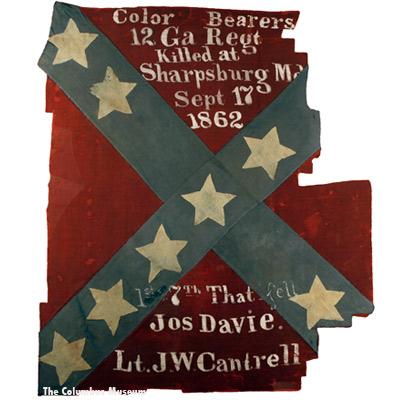
Part of Trimble’s Brigade, the 12th Georgia held part of Jackson’s line in front of the Dunker Church during the morning Union attacks at Antietam. Captain James Rodgers, commanding the 12th, was struck dead by bullets that hit his hand, thigh, and head. This battle flag of the 12th Georgia includes the names of several color bearers who were killed during the tremendous fighting on the morning of September 17, 1862.
Video: The Dunker Church »
The Columbus Museum | Visit the Museum
The 104th New York Volunteers

The 104th New York, known as the Wadsworth Guards, advanced through the Cornfield as part of the I Corps' attack. Carrying this silk regimental flag produced by Tiffany in the Spring of 1862, the 104th engaged Stonewall Jackson’s forces on the morning of September 17, 1862. The flag has two small holes in the upper left that match damage done to the flag staff – likely from two bullets that hit the flag during this fateful march. The 104th suffered 8 killed, 60 wounded, and 14 missing during the 1862 Maryland Campaign.
New York State Military Museum | See More New York Flags
The 1st Texas

Part of John Bell Hood’s hard fighting Texas Brigade, the 1st Texas was sent into the Cornfield as part of a powerful counterattack on the morning of September 17th. Driving the Federal lines back northwards, the 1st Texas was later caught in a maelstrom of bullets and artillery shells that killed or wounded 186 men out of the 226 that they brought into the battle – a staggering 82.6% casualty rate. Eight different color bearers were shot down while carrying this flag in the Cornfield. Unfortunately for this proud regiment, this flag was captured during the unit's withdrawal.
The 1st Texas’ flag, known as "Mrs. Wigfall's Wedding Dress" – was a 6-ft wide Lone Star flag was reportedly made, at least in part, from the wedding dress of Mrs. Louis Wigfall. The 1st Texas received this famous flag in July 1861.
Video: Fight for the Cornfield »
The Texas State Library & Archives Commission | See More Texas Flags
The Dunker Church and West Woods
The 28th Pennsylvania Volunteers
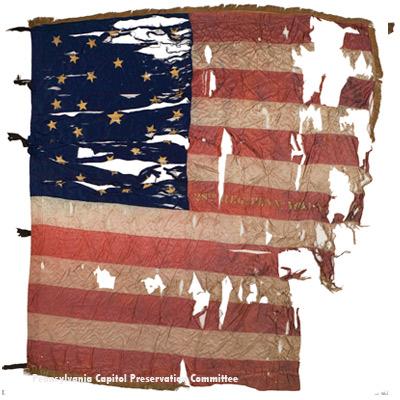
Known as the Goldstream Regiment, the 28th Pennsylvania carried this flag through the Cornfield, past the Dunker Church, and into the West Woods as part of George Sears Greene’s 2nd Division of the XII Corps. Greene’s men pushed Jackson’s Confederates back from the Dunker Church and held an advanced line during the morning of September 17, 1862. Organized in Philadelphia, the 28th Pennsylvania used their Enfield rifles to deadly effect before being pushed back from this advanced line. The 28th would go on to fight at Fredericksburg, Chancellorsville, Gettysburg, and later served in Georgia, Tennessee, and in the 1865 Carolina Campaign.
Video: Greene's Advance at Antietam »
Pennsylvania Capitol Preservation Committee | See More Pennsylvania Flags
The 7th Ohio Volunteers

Formed with men from northeastern Ohio, the 7th Ohio Infantry, carrying this handsome regimental flag, advanced through the Cornfield towards the Dunker Church on the morning of September 17, 1862. Passing the Dunker Church, the 7th Ohio and the rest of the 1st Brigade of Greene’s division entered the West Woods just beyond. It was there in the West Woods that the 7th fought Jackson’s Confederates until around 1:30pm.
The monument to the Ohio troops who took part in this attack (5th Ohio, 7th Ohio, and 66th Ohio) is one of the most visited at Antietam – it's just across the Hagerstown Pike from the Dunker Church.
Ohio Historical Society | See More Ohio Flags
The 66th Ohio Volunteers

The 66th Ohio, like the 7th Ohio above, participated in George Sears Greene’s advance into the West Woods. Carrying this flag into the battle, the 66th would participate in some of the terrible fighting that occurred in and around the Dunker Church. Formed in Urbana, Ohio, the 66th fought in many of the Civil War’s great battles – Port Republic, Antietam, Chancellorsville, Gettysburg, Lookout Mountain, Missionary Ridge, Resaca, Kennesaw Mountain, Atlanta, and Bentonville.
Ohio Historical Society | See More Ohio Flags
The 125th Pennsylvania Volunteers
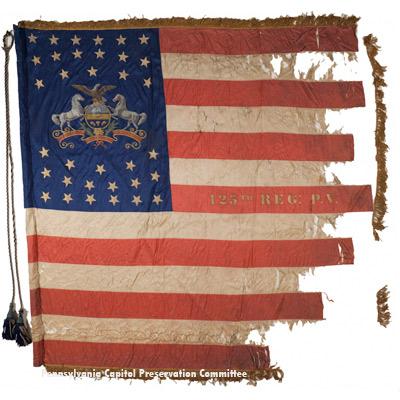
At the vanguard of Joseph Mansfield’s XII Corps advance to the Dunker Church and West Woods, the Battle of Antietam was the first combat engagement for the 125th Pennsylvania. Advancing past the Dunker Church, the 125th found itself isolated in the West Woods, with Confederate forces all around. The 125th watched Gen. Mansfield fall mortally wounded to their right front. While the 125th continued to pour its fire into the nearby Confederate ranks, George Simpson, the 125th’s color bearer, was hit by a bullet in the head and died instantly. As second man picked up this flag and he too was shot down. Two more men would fall holding this flag amidst the carnage of the West Woods. Later, Sgt. W.W. Greenland picked up the flag, stained with the blood of George Simpson, and carried it back across a field to a nearby battery where the remnants of this 9-month division rallied under heavy fire. 29 men of the 125th were killed and another 121 were wounded in roughly 20 minutes of frantic combat within the West Woods. The 125th’s monument in the West Woods features color bearer George Simpson high above its pedestal – still clutching the flag.
Video: Fight for the West Woods »
Pennsylvania Capitol Preservation Committee | See More Pennsylvania Flags
The Sunken Road
The 11th Alabama

Having participated in the capture of Harpers Ferry on September 15, 1862, the 11th Alabama, part of Wilcox’s Brigade, was part of R.H. Anderson’s reinforcement of D.H. Hill’s sagging line in the Sunken Road. Rushed forward to the Confederate right, the 11th Alabama suffered 3 killed and 26 wounded during the intense fight that also led to the capture of this flag by the 57th New York Infantry.
This flag, with its diagonal rip, has intrigued flag scholars for years. Could this be the Confederate battle flag that is seen in the famous photo of George McClellan and Abraham Lincoln after the battle? It matches the descriptions made of it by participants in that famous meeting.
Photo: See the famous McClellan and Lincoln photo »
Alabama Department of Archives & History | See More Alabama Flags
The 61st New York Volunteers
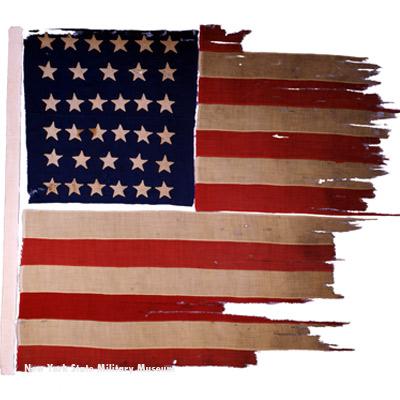
Carrying this wool national color into action, the 61st New York advanced as part of Israel Richardson’s attack on the Confederate right in the Sunken Road. Combined with the 64th New York, this unit was commanded by Col. Francis Barlow and then later by Lt. Col. Nelson Miles – both who would become senior commanders in the Union army by war’s end. Part of Caldwell’s brigade, the men of the 61st New York helped to dislodge the last remaining Confederates from the southern end of the Sunken Road and then proceeded to move on the Piper Farm. At Antietam, the 61st lost 6 killed, 34 wounded, and 1 missing in action. Colonel Miles later deposited this flag with New York state authorities in early 1863. Reportedly the flag is stained with the blood of Sgt. Frank Aldrich, one of the brave color bearers who carried this flag at Antietam.
Video: The Fight for the Sunken Road »
New York State Military Museum | See More New York Flags
The 5th and 8th Florida
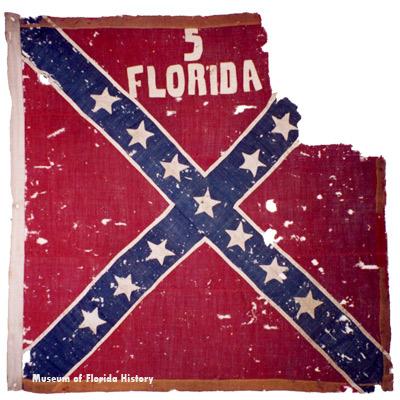

Despite its small population, the State of Florida sent almost 15,000 soldiers into the ranks of the Confederacy. The 5th and 8th Florida, during the 1862 Maryland Campaign, were a part of Pryor’s Brigade in R.H. Anderson’s Division of Longstreet’s Corps. On September 15, 1862, the 5th and 8th Florida participated in the capture of Harpers Ferry – the largest single capture of Federal troops during the Civil War. And during the Battle of Antietam, these two Florida units were hurried forward towards the crumbling Confederate right in the Sunken Road. As part of this counterattack both Colonel John Hateley and Lt. Colonel Thomas Lamar of the Florida 5th were severely wounded. And Lt. Colonel George Coppen of the 8th Florida, a former member of the famed 1st Battalion Louisiana Zouaves, was killed almost immediately as his regiment went into action near the Sunken Road. Captain Richard Waller assumed command of the 8th Florida and he too was killed with the regiment’s colors draped over his shoulders. At Antietam, the entire color guard was killed or wounded.
Museum of Florida History | Visit the Museum
Burnside's Bridge and the Final Attack
The 51st Pennsylvania Volunteers

Commanded by Col. John Hartranft, the 51st Pennsylvania and the 51st New York were ordered to take the Rohrbach Bridge (later known as Burnside’s Bridge) after two earlier Federal attacks had failed. Charging down the wooded hillside, the 51st Pennsylvania was immediately taken under fire by the Georgians dug in on the far bank. Breaking through and over a fenceline skirting the road near the bridge, the 51st , carrying this flag, charged over the span as bullets struck home. Col. Hartranft led his men across the bridge and to the far bank where they were able to scatter the remaining Confederate defenders. Once resupplied, the 51st Pennsylvania took part in the final Union attacks near the town of Sharpsburg. The 51st Pennsylvania lost 21 killed and 99 wounded during the Battle of Antietam.
Video: The Taking of Burnside's Bridge »
Pennsylvania Capitol Preservation Committee | See More Pennsylvania Flags
The 9th New York Volunteers

The 9th New York regiment, a Zouave regiment, carried this regimental flag during the Battle of Antietam. On June 5, 1861, the regiment received this silk flag outside the 5th Avenue home of Mrs. William Moffatt. While hard to read today, the regiment's motto, “Toujours Pret” (always ready), is present just underneath the regiment's name. After fording the Antietam Creek at Snavely’s Ford, the 9th New York continued the advance towards the town of Sharpsburg in the afternoon of September 17, 1862. During the afternoon fight, Captain Adolphe Libaire grabbed the colors from a fallen color bearer. Rallying the 9th with this flag, Libaire would lead the troops forward against D.R. Jones’ Confederates near the Harpers Ferry road. For this brave action, Libaire would earn the Medal of Honor in 1898. In 1899, veterans of the 9th handed this flag over to Governor Theodore Roosevelt. The 9th lost 63% of its soldiers during the 1862 Maryland Campaign.
New York State Military Museum | See More New York Flags
The Pee Dee (South Carolina) Artillery

Having accompanied A.P. Hill’s Light Division on its 15 mile forced march from Harpers Ferry, McIntosh’s South Carolina Battery (Pee Dee Artillery) came onto the field around 2:30pm on September 17th. This unit, which was comprised of one 10-pdr. Parrott, one 3-in. Ordnance Rifle, one 12-pdr. Napoleon, and one 12-pdr. Howitzer, began firing on Rodman’s Division of the Union IX Corps as it advanced towards the town of Sharpsburg. Being driven from their guns, the men of the Pee Dee artillery were able to retake their positions after the arrival of Toombs and Archer’s Brigades. Artillery units like the Pee Dee artillery played a key role in holding off the advance of the IX Corps as it sought to take the town of Sharpsburg and sever Lee’s likely line of retreat to the Potomac.
Video: A.P. Hill Counterattacks »
Related Battles
12,401
10,316

